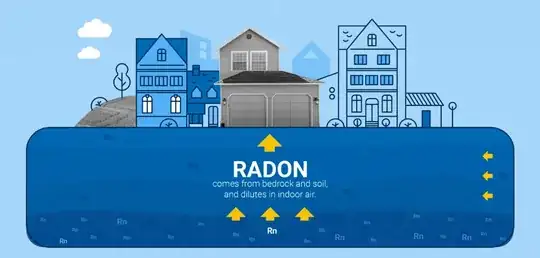Sulfur dioxide and Nitrogen dioxide
It seems to me that you're asking for a gas that fulfills three core requirements: (a) it is toxic to plants and animals (b) it is denser than air, so it will settle at lower altitudes (c) you want an explanation for how it would form on a planet. Sulfur and nitrogen oxides fulfill these requirements, assuming your planet resembles Earth.
(a) Toxic to humans and plants
Sulfur dioxide (SO2) and nitrogen dioxide (NO2) are both gases that are toxic to human and plants. They have severe effects on the respiratory tract in humans and can inhibit growth in plants:
Sulfur dioxide is a severe irritant to the respiratory tract, eyes, mucous membranes, and skin. Exposure to high doses can cause pulmonary edema, bronchial inflammation, and laryngeal spasm and edema with possible airway obstruction. There is no antidote for sulfur dioxide.
Sulfur dioxide inhibits photosynthesis by disrupting the photosynthetic mechanism. The opening of the stomata is promoted by sulfur dioxide, resulting in an excessive loss of water. The cumulative effect of sulfurous pollution is to reduce the quantity and quality of plant yield.
Elevated levels of nitrogen dioxide can cause damage to the human respiratory tract and increase a person's vulnerability to, and the severity of, respiratory infections and asthma. Long-term exposure to high levels of nitrogen dioxide can cause chronic lung disease.
At high concentration levels, nitrogen dioxide is potentially toxic to plants, can injure leaves and reduce growth and yield. In combination with either ozone (O3) or sulphur dioxide (SO2), nitrogen dioxide may cause injury at even lower concentration levels.
As indicated by the last quote, sulfur dioxide and nitrogen dioxide are most harmful in combination. When combined, you can get the same effect at lower levels.
(b) More dense than air
SO2 and NO2 are both denser than air. Air at sea level has a density of about 1.2 kg/m3. In contrast, the density of sulfur dioxide is 2.86 kg/m3 and nitrogen dioxide is 2.05 kg/m3. They will easily settle to lower altitudes.
(c) Produced by fossil fuel consumption
Sulfur dioxide and nitrogen dioxide are byproducts of fossil fuel consumption. They are formed during the combustion of fossil fuels such as coal, gas, and oil, especially from fuel used in cars.
Fossil oil is largely made up of carbon and hydrogen which form carbon dioxide (CO2) and water following combustion in air. The combustion of fossil oil also creates sulphur oxides (SOx) and nitrogen oxides (NOx) and these are believed to have a detrimental effect on the environment, the atmosphere and the ozone layer.
Sounds like exactly the combination you want.
